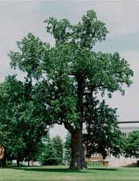 Photo by Tom Darden
Photo by Tom Darden
|
The Maryland Liberty Tree
Annapolis, Maryland
Tulip Poplar ~ Liriodendron Tulipifera
|
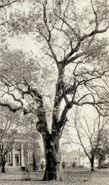 Maryland State Archives
Maryland State Archives
|
Sons of Liberty and The Stamp Act
The Sons of Liberty were groups formed in colonial cities and towns to oppose the Stamp Act of 1765 and force its repeal by Parliament. William Paca and Samuel Chase, two future signers of the Declaration of Independence, organized Annapolis-area patriots into a chapter of the Sons of Liberty in early 1766.
In some communities, American patriots assembled at Liberty Trees for public meetings and protests. Annapolis’ Liberty Tree, a tulip poplar, stood near the incomplete and derelict “Governor’s Folly,” now McDowell Hall on the campus of St. John’s College.
Daniel Dulany, a prominent Annapolis attorney and politician, was the best-known and most articulate local critic of the Stamp Act. His stirring words, printed and sold in pamphlet form by Jonas Green, publisher of the Maryland Gazette, helped marshal all of the colonies to resist taxation without representation.
Although the Stamp Act was repealed in 1766, it was replaced by other taxes as Parliament continued to assert its right to levy taxes on American colonists. The Townshend Duties of 1767 and the Tea Act of 1773 prompted patriots in Annapolis and many other communities to boycott British imports.
The Peggy Stewart and the Annapolis Tea Party
On October 19, 1774, patriots met to consider how to respond to the arrival in Annapolis harbor of a ship named Peggy Stewart, owned by a partnership that included merchants Anthony Stewart and James Dick. The ship carried 2,320 pounds of boycotted tea intended for T. C. Williams & Co. Stewart, Dick, and the Williamses all had histories of challenging boycott agreements, so many patriots were in no mood to let them off easily for this latest transgression.
Moderates thought the tea should be destroyed, as had been done at the Boston Tea Party ten months earlier, but radicals threatened Anthony Stewart with tarring and feathering and risk of further harm to himself, his family, and his Hanover Street house unless he destroyed the entire ship. In fear for their personal safety, Stewart and two of the Williamses ran the Peggy Stewart aground and set it on fire. Patriots cheered from shore as the ship burned down to the waterline and sank.
While the initial gathering point for the Peggy Stewart protesters is not known, by the mid-1770s Liberty Trees had become symbols of the growing patriot movement in port cities from Boston to Charleston. A September 27, 1775 letter by William Eddis, an Annapolis official, recorded that “This morning early we were alarmed by the beating of drums and a proclamation for the inhabitants to assemble at the Liberty Tree.”
During the Revolutionary War, the British so hated these emblems of American rebellion that when they occupied Boston and Charleston, they cut down the local Liberty Trees. Annapolis was never occupied during the conflict, and its Liberty Tree would become the oldest living survivor of the Revolutionary era.
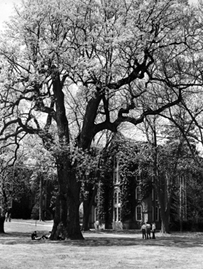
Maryland Liberty Tree
Annapolis, Maryland
1842
|
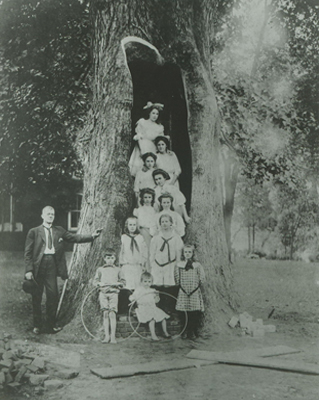
Maryland Liberty Tree
Annapolis, Maryland
1907
|

Maryland Liberty Tree
Annapolis, Maryland
date unknown
|
The Maryland Liberty Tree’s Last Chapter
In the 1840s, schoolboys exploded two pounds of gunpowder in a hollow in the tree. It was feared the tree would not survive, but the next year the tree put out lush new growth. The fire had burned out rotted wood and fungus, searing the inside core. In 1907 steel rods were added and 55 tons of cement were poured into the tree’s core in the attempt to further preserve it. In the 1970’s cables and bolts were installed for trunk and branch support.
On September 16, 1999 Hurricane Floyd blew into Annapolis, cracking the Liberty Tree's trunk and a major limb. Concerned about the tree’s potential collapse, the college brought in experts who concluded the damage was too great for traditional repairs such as bracing and wiring. On October 25, 1999 the Maryland Liberty Tree was taken down following a solemn memorial ceremony. St. Johns College kept a small portion of the wood for memorabilia for the college and bystanders took small branches and leaves for personal memories and keepsakes.
Mark Mehnert, an Annapolis resident and landscaper watched as the tree was taken down over 4 days and was so concerned the tree be preserved he followed the dump trucks loaded with wood. The wood was hauled to the Millersville, MD landfill and two northern Virginia recycling plants. Some was quickly turned into mulch but Mark persuaded the landfill owner to hold the remaining wood while he arranged to transport it to safety.
After a year of expensive curing, storage and transport costs, Mark offered a portion of the wood for sale to Bob Taylor of Taylor Guitars. Taylor made a limited edition of 400 Liberty Tree guitars to “ pay homage to the symbols of our past and the tenets of our future.” Mark Mehnert also gave the seeds he had collected to American Forest’s Historic Tree Nursery. American Forest has since presented 14 seedlings to the state of Maryland. Similar presentations are planned for each of the 13 original colonies with the 14th tree to be planted at the White House.
The Maryland Liberty Tree
Annapolis, Maryland
Tulip Poplar ~ Liriodendron Tulipifera
• Age estimate: 400 years old
• Height: 96-97 feet
• Girth: 27 feet
|
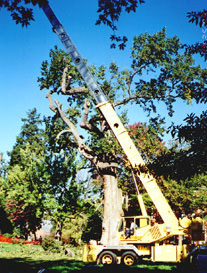
Photo by Mary McGee
October 25, 1999
|
Cynthia McBride
July 2008 - “Annapolis: A Living History” exhibit at McBride Gallery
Credit: Historic Annapolis Foundation for data on the Sons of Liberty, the Stamp Act and the Peggy Stewart
Special Exhibit of Liberty Tree Wood
A special exhibit of wood from the Maryland Liberty Tree that stood for over 400 years in Annapolis on St. John’s College campus will be on display at McBride Gallery July 1 - July 31, 2008. Howard Buffington, representing a properly dressed colonist, will talk of the history and significance of the colonial Liberty Trees and share some stories about the Annapolis tree. He will speak and take questions for 10 – 15 minutes at 6:00, 7:00 and 8:00pm on Saturday, July 12th.
|
